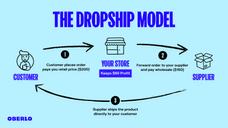The Anatomy of Dropshipping – Is It a Profitable eCommerce Model?
Sector: Digital Commerce
Author: Nisarg Mehta
Date Published: 03/14/2023

Contents
Dropshipping has become a popular eCommerce model for entrepreneurs looking to start their own online businesses.
A recent survey shows over 27% of online sellers use dropshipping as their primary fulfillment method.
It is because, with the rise of platforms such as Amazon FBA and Red Stag Fulfillment, it has never been easier to start an eCommerce business. However, many eCommerce businesses are still unsure of whether or not dropshipping is a profitable model.
Therefore, we will take a deep dive into the anatomy of dropshipping and explore the pros and cons of this eCommerce model. We will also discuss some of the top dropshipping providers, such as Oberlo, Amazon FBA, and Spocket, and how they can help you start your own successful dropshipping business.
What is Dropshipping?
Dropshipping is a modern-world eCommerce business model where a third party (dropshipping provider) handles the purchase and delivery of items to the customer.
This way, the retailer (online business) does not have to hold any inventory or handle shipping. Instead, when the retailer gets a product request from the customer, it purchases the item from a third-party (droshipper) and has it shipped directly to the customer.

For example, if a company sells sports apparel online, it could use dropshipping to source and ship that apparel from a manufacturer or distributor. The retailer would list the product for sale in their online store, process orders from customers, take payments, and then place an order with the dropship provider, who will supply the item directly to the customer.
This method of retailing allows companies to quickly and cost-effectively get products into the market without having to worry about storage capacity or delivery issues.
Of course, every business model comes with its own pros and cons. Let’s dive deep into the advantages of dropshipping first.
Advantages of Dropshipping for Online Retailers
Following are the reasons why dropshipping is increasingly becoming popular among online retailers:
Requires Less Capital Upfront
Online retailers that leverage dropshipping do not have to buy in bulk or handle the stock or products themselves. With dropshipping, an online business can start with a relatively small investment and will only spend money when an order has been placed. This helps online retailers minimize their risk, as there’s no need to keep buying inventory that may not sell.
Enables the Selling of a Wide Variety of Products
Dropshipping allows online retailers to offer a wide range of products without taking on any physical inventory, storage, and fulfillment process. The retailer only needs to pay for what they sell, and there is no need for them to worry about excess inventory or storage. This means that a company can offer an extensive selection of products from various suppliers without having to stock them, saving both time and money.
Infuses Scalability
Dropshipping allows online retailers to scale their business easily. Since the retailer does not need to worry about inventory or storage, they can easily add more products to their store by sourcing them from suppliers. This makes it easier for the retailer to add new products to their site as they don’t need to invest money upfront in inventory.
Additionally, orders can be processed much faster since there is no need for the retailer to store and check on stock physically.
No Need to Handle Shipping and Returns
With dropshipping, online retailers don’t need to handle shipping and returns. This is because the supplier is responsible for shipping the products directly to customers. So, when a customer makes a return, they ship the product back to the supplier instead of the retailer, which streamlines and simplifies the process for both parties. The retailer does not need to worry about stocking or shipping products, as the supplier handles this.
Additionally, returns can be processed quickly since all that’s required is for customers to send them back to their supplier instead of manually checking them at a retail store or warehouse.
No Fuss About Inventory Management
Dropshipping eliminates the tedious and time-consuming task of managing stock levels, ordering new products in advance, and checking for the availability of goods. Additionally, it eliminates the need to store and handle physical products, saving time and money.
Dropshipping easily eliminates many of the challenges associated with inventory management, such as product obsolescence; if a product isn’t selling well or becomes outdated quickly, it can be removed from the website without having to worry about disposing of unsold stock or tying up finances in slow-selling items.
No Geographical Restrictions
Thanks to dropshipping, online retailers have access to an endless supply of products that would otherwise be unavailable due to distance (making it impossible for the retailer to manage their inventory from afar). As a result, online retailers do not need a physical storefront or any related infrastructure, making them free from costly location and investment needs.
Furthermore, with dropshipping, international customers can shop like any other local customer; orders are shipped directly from the supplier to the customer’s door, regardless of their location. This ensures a fast and cost-effective shipping process with fewer delays.
Dropshipping leaders such as Shopify are even rewarding stores with more sales opportunities by listing products on multiple global marketplace sites such as eBay and Amazon.
Drawbacks of Dropshipping and How to Overcome Them
The following are some of the critical cons of dropshipping that online retailers should overcome while adopting this business model:
Low Margins
One of the biggest challenges for online sellers using dropshipping is the low margin. Since dropshippers must rely on a third-party provider to manage the storage, handling, and delivery of goods, they often have to pay additional fees to get their products. These additional fees often include inventory costs, stock management fees, and shipping rates which can all significantly reduce their profit margins.
To overcome this challenge, online retailers should focus on streamlining as many processes as possible and negotiating better deals with dropshippers in order to lower costs. Additionally, they should understand how the market works so they can make informed decisions when it comes time to renegotiate contracts or choose different suppliers.
Additionally, online retailers should take advantage of marketing tools like email campaigns and influencer marketing that can help boost sales while also helping them improve their average order value so that lower margins don’t hurt their bottom line as much.
No Inventory Insights and Control
Another challenge with dropshipping is that online retailers have little to no insight and control over their inventory. This can be problematic since they may not be able to accurately predict demand for products, track shipments and deliveries, or ensure timely delivery of goods to customers.
To overcome this challenge, retailers should seek out dropshipping partners who are transparent and reliable. They should also establish clear processes and policies around ordering, shipping confirmation, communication, quality control processes, etc.
Additionally, they can invest in dropshipping software like Shopify to gain greater visibility into their stock levels and automate in-stock notifications, so they are better able to go ahead with orders without being stuck waiting for updates from their dropshipper on availability.
Shipping Complexities
As online retailers work with third-party providers and don’t handle, store or ship the product orders themselves, there can be discrepancies between what the customer expects, what is communicated by the dropshipper, and what is actually delivered.
To overcome this challenge, retailers should establish clear processes and policies around order tracking and communication between them and their dropshippers.
Additionally, they should negotiate favorable terms with their dropshipping providers, such as free shipping or discounts on shipping costs, to make it easier for customers to purchase from them.
Limited Personalization and Branding Opportunity
Online retailers rely on third-party providers and may not have control over how the product is shipped. This makes it more challenging for them to create a unique customer experience that aligns with their own brand values.
To overcome this challenge, online retailers can invest in custom packaging materials, such as custom boxes, bags, and labels. They can also ask their dropship provider to include product brochures or other marketing materials along with the shipment.
Additionally, they could provide rewards and exclusive discounts to customers who purchase from them through dropshipping. This will help emphasize a personalized customer experience and build loyalty for the retailer’s brand.
Commonly Asked Questions about Dropshipping
Here are some questions we found people frequently asking on dropshipping:
1. How does dropshipping work?
Dropshipping is an order fulfillment eCommerce technique in which a third-party supplier or dropshipper ships products directly to customers on behalf of a retailer. This eliminates the need for a retailer to stock inventory and manages shipping and fulfillment costs.
When an online store receives an order, they place the same order with its dropship supplier, provides the shipping information, and the supplier ships the order to the customer’s address. The dropshipper is typically responsible for stocking inventory, fulfilling orders, packing goods for shipment, and handling customer service inquiries.
2. What are the costs associated with dropshipping?
Dropshipping typically incurs some start-up costs, such as a subscription to a dropshipping service and setting up a payment gateway for customers. In addition, merchants will typically be charged for dropshipping services and shipping charges.
Some dropshippers may also charge fees for setup, marketing, cancellations, or returns. The cost of each purchase order should also be taken into account when calculating the overall cost of dropshipping.
3. How do I find a reliable supplier for my dropshipping business?
Finding a reliable supplier for a dropshipping business can be a challenge, but you can use the following strategy to increase your chances of success:
- Research suppliers: Look for suppliers that have a good reputation in your niche and have been in business for a long time. You can find supplier reviews and ratings on websites like Alibaba and SaleHoo.
- Check for certifications: Look for suppliers that have certifications like ISO 9001 or BSCI, which indicate that the supplier adheres to certain quality standards.
- Communicate with suppliers: Reach out to potential suppliers and ask them questions about their business, such as their lead times and minimum order quantities. This can help you gauge their responsiveness and reliability.
- Order a sample: Before you commit to a large order, consider ordering a small sample of their products to test the quality and make sure they meet your needs.
- Check their website: A professional and detailed website is a good indication of a supplier’s credibility.
- Check the location: If possible, try to find a supplier that is located in the same country as you. This will make communication and shipping more efficient.
Using this strategy will increase your chances of finding a reliable supplier and building a successful dropshipping business.
4. How do I handle shipping and tracking for dropshipped products?
Several software options are available for tracking and managing dropshipped products. Some popular options include:
- Shopify: Shopify is an eCommerce platform that offers a variety of apps and plugins for shipping and tracking. Some apps, such as AfterShip, allow you to track and update shipping information for your customers automatically.
- Oberlo: Oberlo is a Shopify app specializing in dropshipping and includes a built-in tracking feature that enables you to track the status of your orders and update your customers.
- AliDropship: AliDropship is a WordPress plugin for eCommerce that enables you to import products from AliExpress and manage shipping and tracking. It has a built-in order tracking feature allows you to track your orders and update your customers.
- Spocket: Spocket is a Shopify app that allows you to import products from a variety of suppliers and has a built-in order-tracking feature.
- Dropified: Dropified is a software that allows you to import products from multiple sources, including AliExpress and Amazon, and has a built-in order tracking feature.
These are just a few examples. Many other software options are available, depending on your specific needs and preferences. It’s best to research and compare different options to find the one that works best for you.
Step-by-Step Guide for Getting Started with Dropshipping
If you want to start a dropshipping-backed online store, here is a step-by-step process for you:
- Research and choose a niche for your dropshipping business
- Find a reliable supplier for your chosen niche
- Create an online store or a website to sell the products
- Add the products to your website
- Test your website and make the necessary adjustments
- Start driving traffic to your website and start selling
- Continuously monitor and optimize your business
Conclusion
Dropshipping offers several advantages for retailers. One of the main advantages is that it allows retailers to sell a wide range of products without holding any inventory. This eliminates the need for retailers to invest in expensive warehouse space and reduces the risk of stock becoming obsolete.
Additionally, dropshipping allows retailers to test the demand for new products without incurring significant upfront costs. It also makes it easy to add new products to their online store without worrying about the logistics of sourcing and storing them.
Furthermore, dropshipping allows retailers to operate their business from anywhere with an internet connection, as they don’t need to be physically close to the warehouse. Overall, dropshipping is a cost-effective and low-risk way for online retailers to expand their product offerings and grow their business.
So if you’re looking to start your dropshipping business, you would need technical support to build your online store and integrate it with dropshipping service providers. Feel free to reach us, as we have eCommerce experts onboard that can help you get going.
Latest Tech Insights!
Join our newsletter for the latest updates, tips, and trends.



